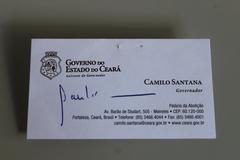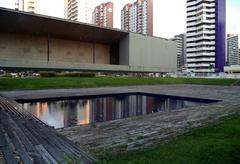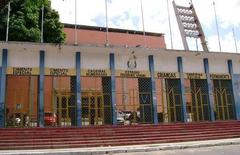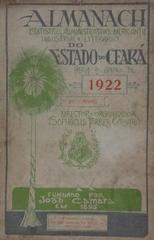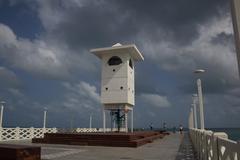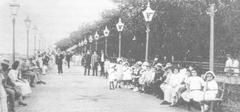Casa do Português Fortaleza, Brazil: Visiting Hours, Tickets, and Historical Sites Guide
Date: 04/07/2025
Introduction
Casa do Português in Fortaleza, Brazil, stands as a significant emblem of Portuguese heritage and architectural innovation in northeastern Brazil. This landmark not only chronicles the historical journey and cultural contributions of Portuguese immigrants but also showcases Fortaleza’s dynamic urban evolution. Spread across notable neighborhoods such as Aldeota, Damas, and Vila Santo Antônio, the various buildings known as Casa do Português offer unique insights into the fusion of traditional Portuguese motifs—like azulejos, wrought-iron balconies, and arched windows—with distinct Brazilian adaptations (Associação Portuguesa de Beneficência do Ceará; ipatrimonio.org).
While several structures share the Casa do Português name, each holds a particular story: from the vibrant cultural hub in Aldeota, inaugurated in 1966 and actively promoting Portuguese-Brazilian arts and community programs, to the monumental mid-century mansion in Damas recognized for its bold, eclectic style and unique architectural features, and the early 20th-century Vila Santo Antônio residence, a testament to the legacy of Portuguese immigrant José Maria Cardoso. Together, these sites underscore the depth and impact of Portuguese influence on Fortaleza’s identity.
This guide provides a comprehensive overview of Casa do Português, covering its architectural highlights, historical background, cultural significance, visitor information (including opening hours, tickets, and accessibility), nearby attractions, preservation efforts, and practical tips for travelers. For the most current updates and digital resources, including virtual tours and online programming, consult the official Casa do Português website (Casa do Português - Digital).
Casa do Português in Aldeota: Cultural Center and Visitor Experience
Overview and Historical Significance
The Casa do Português cultural center in Aldeota operates as a focal point for Portuguese culture in Fortaleza. Founded in 1966 by the Associação Portuguesa de Beneficência do Ceará—originally established in 1925—this institution preserves and celebrates Portuguese traditions through a range of social, artistic, and philanthropic programs (Associação Portuguesa de Beneficência do Ceará). Architectural highlights include classic azulejos, arched windows, and elegant wrought-iron balconies, all integrated with Brazilian stylistic elements.
Community Role
Since its opening, the Casa has served as a gathering place for the Portuguese community, hosting annual events such as the Festa de São João and Dia de Portugal, which draw hundreds of participants (Diário do Nordeste). The center also provides language classes, legal support, and social integration services for immigrants, while its library and ballroom foster broader cultural exchange.
Activities and Events
Workshops on traditional Portuguese crafts, tile painting, embroidery, and culinary arts (featuring dishes like bacalhau and pastel de nata) are held regularly. The library houses over 3,000 Portuguese-language volumes, and cultural events include fado concerts, folk dances, and art exhibitions (Casa do Português - Biblioteca). The institution has expanded to support philanthropic initiatives, scholarships, and health campaigns, welcoming both Portuguese descendants and the wider Fortaleza community (O Povo).
Visitor Information
- Opening Hours: Tuesday to Sunday, 10:00 AM – 6:00 PM. Closed on Mondays and major holidays.
- Admission: Free entry.
- Address: Rua Barão do Rio Branco, 1234, Aldeota, Fortaleza, Ceará.
- Accessibility: Wheelchair accessible with ramps and elevators.
- Parking/Public Transport: Ample parking nearby; several bus lines stop within walking distance.
Guided Tours and Exhibitions
Guided tours are available on weekends and public holidays, offering historical context and highlighting the building’s architectural features. Permanent exhibitions focus on Portuguese immigration, crafts, and Lusophone literature.
Special Events
The annual Dia de Portugal festival (June 10th) is a major event, featuring music, culinary fairs, and parades (Prefeitura de Fortaleza). Additional concerts, exhibitions, and workshops occur throughout the year.
Photographic Highlights
Photo opportunities include the azulejo-adorned façade, grand ballroom with chandeliers, and restored wood paneling.
Digital Resources
The official website offers virtual tours, digital archives, and online language courses, making Casa do Português accessible to a global audience (Casa do Português - Digital).
Casa do Português in Damas: Architectural Landmark and Preservation
Architectural Features
Located at Av. João Pessoa, nº 5094 in the Damas neighborhood, this mid-20th-century mansion—originally Vila Santo Antônio—was completed in 1953 by Portuguese merchant José Maria Cardoso (ipatrimonio.org). The building is notable for its:
- Monumental scale: Four stories with a broad spiraling ramp allowing vehicular access to all floors.
- Eclectic style: A combination of Mission Style Californiano arches, modernist concrete elements, and elevated walkways.
- Arcaded façade: Repetitive arches evoke Mediterranean nostalgia.
- Historic details: The original “Vila Santo Antônio” plaque remains visible.
Current Status and Accessibility
Casa do Português in Damas is currently a private residence, inhabited by multiple families. Public access is restricted—there are no regular visiting hours, ticket sales, or official guided tours. Visitors may admire the building’s exterior from the street but should not attempt unauthorized entry (ipatrimonio.org).
- Best visiting time: Daylight hours for optimal photography.
- Location: Av. João Pessoa, Damas neighborhood.
- Public transport: A bus stop is located directly in front.
Preservation and Challenges
Despite being listed as a protected heritage site in 2012 (Decree n° 13.036/2012), Casa do Português faces significant preservation challenges, including neglect and a lack of restoration funding. The building’s impressive structure is admired by locals and visitors alike, but urgent conservation is needed to prevent further deterioration (ipatrimonio.org).
Cultural Significance
The mansion symbolizes both individual immigrant success and the broader Portuguese-Brazilian cultural connection. Its adaptability over the years—from family residence to nightclub and offices—demonstrates its importance in the urban landscape.
Casa do Português in Vila Santo Antônio: Historical Legacy
Historical Context
The early 20th-century mansion in Vila Santo Antônio, also known as Casa do Português, was originally owned by José Maria Cardoso. It stands as a testament to Fortaleza’s multicultural heritage and urban development (Fortaleza Nobre). The house embodies the legacy of one of the city’s prominent Portuguese immigrants and remains a vessel of collective memory for Fortaleza.
Accessibility
Currently, the mansion is not open to the public due to preservation and safety issues. Entry is discouraged, but local heritage walking tours may include the site in their narratives.
Preservation Efforts
Protected by the municipal government, the mansion faces challenges from neglect, vandalism, and funding shortages. Community advocates and local descendants continue to propose its revitalization as a museum or cultural hub.
Complementary Experiences: Nearby Attractions
While access to the interiors of Casa do Português buildings may be limited, visitors can explore other notable sites in Fortaleza’s cultural corridor:
- Mercado Central de Fortaleza: The largest craft and souvenir market in Brazil (brazilexplained.com).
- Theatro José de Alencar: A renowned Art Nouveau theater (brazilexplained.com).
- Centro Dragão do Mar de Arte e Cultura: A major arts complex drawing over a million visitors annually (brazilexplained.com).
- Fortaleza Metropolitan Cathedral: Neo-Gothic architecture inspired by Notre Dame (brazilexplained.com).
Safety and Practical Tips
- Safety: Fortaleza is vibrant but has higher-than-average crime rates. Avoid carrying valuables, remain vigilant, and avoid walking alone at night (brazilexplained.com).
- Best visiting time: The dry season (July–December) offers optimal weather for sightseeing.
- Duration: Visits to exterior sites are brief, but combining Casa do Português with nearby attractions can enrich your itinerary.
Preservation, Restoration, and Future Prospects
Casa do Português’s future hinges on restoration and adaptive reuse. Legal heritage protection exists, but progress depends on funding, advocacy, and public policy. Community involvement and innovative uses—such as a cultural center or museum—could revitalize the building and enhance its role in Fortaleza’s urban development (worldbank.org).
Frequently Asked Questions (FAQ)
Q: What are the visiting hours for Casa do Português?
A: The Aldeota cultural center is open Tuesday to Sunday, 10:00 AM – 6:00 PM. The Damas and Vila Santo Antônio buildings are not open to the public.
Q: Is there an entrance fee?
A: The Aldeota center offers free admission. Other sites have no ticketing because they are closed to visitors.
Q: Are guided tours available?
A: Guided tours are offered at the Aldeota cultural center on weekends and public holidays. No tours are available at the Damas or Vila Santo Antônio sites.
Q: Can I enter the Damas or Vila Santo Antônio houses?
A: No. Access is restricted; visitors may view the exterior only.
Q: What safety precautions should I take?
A: Exercise caution, especially at night, and avoid carrying valuables.
Q: What other attractions are nearby?
A: Mercado Central, Theatro José de Alencar, Centro Dragão do Mar, and Fortaleza Cathedral.
How to Support Preservation
Support local heritage organizations, participate in cultural events, and raise awareness by sharing photos (from public spaces) and stories on social media. Engaging with community initiatives can help ensure the future of these historic sites.
Summary and Final Tips
Casa do Português, in its various incarnations across Fortaleza, stands as a vibrant testament to the enduring legacy of Portuguese immigration and cultural exchange in northeastern Brazil. Whether attending a festival in Aldeota, admiring architectural details in Damas, or learning about the mansion’s history in Vila Santo Antônio, visitors engage with a living narrative of urban development and heritage preservation (Associação Portuguesa de Beneficência do Ceará; ipatrimonio.org).
Public access and programming vary: the Aldeota cultural center welcomes visitors with free entry and a robust events calendar, while the Damas and Vila Santo Antônio buildings are currently closed to the public due to preservation needs. Exploring nearby cultural landmarks, supporting restoration efforts, and staying informed through official channels are the best ways to appreciate and help sustain Fortaleza’s rich historical tapestry.
For updates on visiting hours, events, and digital resources, consult the Casa do Português official website and consider downloading the Audiala mobile app for curated cultural experiences across Fortaleza. By engaging with these sites and sharing their stories, you contribute to the ongoing celebration and preservation of this unique heritage (Diário do Nordeste; ipatrimonio.org).
References and External Links
- Associação Portuguesa de Beneficência do Ceará
- Diário do Nordeste
- Fortaleza Nobre
- ipatrimonio.org
- Prefeitura de Fortaleza
- Casa do Português - Digital
